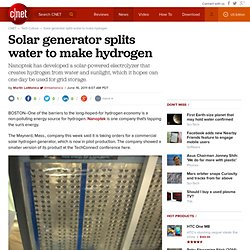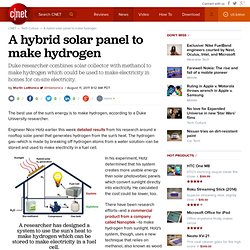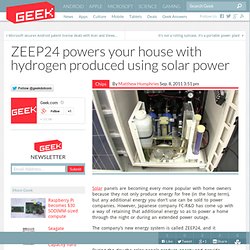

Verde LLC-Our product line of Solar Panels,Gas Generators and Wind Turbines. SHG300™ Solar H2 Generator. 'Artificial leaf' makes hydrogen from solar cell. Drawing from nature, Massachusetts Institute of Technology professor Daniel Nocera thinks he can draw cheap and clean energy from water.

At the National Meeting of the American Chemical Society, Nocera yesterday presented results from research on making an "artificial leaf" to split water to get hydrogen fuel and oxygen. The goal is to use the solar cell to make hydrogen, which would be stored and then used in a fuel cell to make electricity. "The artificial leaf shows particular promise as an inexpensive source of electricity for homes of the poor in developing countries. Solar generator splits water to make hydrogen. BOSTON--One of the barriers to the long-hoped-for hydrogen economy is a non-polluting energy source for hydrogen.

Nanoptek is one company that's tapping the sun's energy. The Maynard, Mass., company this week said it is taking orders for a commercial solar hydrogen generator, which is now in pilot production. The company showed a smaller version of its product at the TechConnect conference here. Nanoptek envisions creating a system for storing energy from solar at large scale, making hydrogen for vehicles, and even home fueling.
In the nearer term, though, the company is seeking to sell solar generators to businesses that now buy tanks of hydrogen for industrial use. The company's product, called the Solar Hydrogen Generator 300, is slightly bigger than a typical solar photovoltaic panel, measuring two meters wide and one meter high. A hybrid solar panel to make hydrogen. The best use of the sun's energy is to make hydrogen, according to a Duke University researcher.

Hydrogen and Fuel Cells Research - Hydrogen Production and Delivery. Most of the hydrogen in the United States is produced by steam reforming of natural gas. For the near term, this production method will continue to dominate. Researchers at NREL are developing advanced processes to produce hydrogen economically from sustainable resources. NREL's hydrogen production and delivery R&D efforts, which are led by Huyen Dinh, focus on the following topics: Biological Water Splitting Certain photosynthetic microbes use light energy to produce hydrogen from water as part of their metabolic processes.
Related publications: Geek.com. Solar panels are becoming every more popular with home owners because they not only produce energy for free (in the long term), but any additional energy you don’t use can be sold to power companies.

However, Japanese company FC-R&D has come up with a way of retaining that additional energy so as to power a home through the night or during an extended power outage. The company’s new energy system is called ZEEP24, and it combines solar power, water and hydrogen to create a self-sufficient energy generating unit. During the day the solar panels produce energy and provide power for the house. Direct-Thermal Solar Hydrogen Production from Water Using Nozzles/Skimmers and Glow Discharge in the Gas Phase at Low Pressure and High TemperatureDirect-Thermal Solar Hydrogen Production from Water Using Nozzles/Skimmers and Glow Discharge in the Gas Pha. Back Home W.R. Pyle, M.H. Hayes, A.L. Spivak H-Ion Solar Company 6095 Monterey Avenue Richmond, California, 94805 Tel: (510) 237-7877 FAX: (510) 232-5251 Info@hionsolar.com Hionsolar@aol.com. h2_tech_roadmap. Hydrogen fuel tech gets boost from low-cost, efficient catalyst.
May 3, 2011 — Scientists have engineered a cheap, abundant alternative to the expensive platinum catalyst and coupled it with a light-absorbing electrode to make hydrogen fuel from sunlight and water.

The discovery is an important development in the worldwide effort to mimic the way plants make fuel from sunlight, a key step in creating a green energy economy. It was reported in Nature Materials by theorist Jens Nørskov of the Department of Energy's SLAC National Accelerator Laboratory and Stanford University and a team of colleagues led by Ib Chorkendorff and Søren Dahl at the Technical University of Denmark (DTU). Chance discovery may revolutionize hydrogen production. Producing hydrogen in a sustainable way is a challenge and production cost has so far proven to be too high.

Now a team led by EPFL Professor Xile Hu has discovered that a molybdenum based catalyst is produced at room temperature, inexpensive and efficient. The results of the research are published online in Chemical Science. An international patent based on this discovery has just been filled. Existing in large quantities on Earth, water is composed of hydrogen and oxygen. It can be broken down by applying an electrical current; this is the process known as electrolysis. Industrial prospects The new catalysts exhibit many advantageous technical characteristics.
It's only by chance that Daniel Merki, Stéphane Fierro, Heron Vrubel and Xile Hu made this discovery during an electrochemical experience. Clean, cheap hydrogen production from water using cobalt catalyst. For years, proponents of the hydrogen economy have argued that hydrogen will replace traditional hydrocarbon fuels for transportation purposes.

But, so far, a lack of new, inexpensive methods for hydrogen production and storage has impeded this goal. Over the last several years, an MIT professor has been pushing cobalt catalysts as a cheap replacement for the expensive metals typically used to split water. A paper in this week's Proceedings of the National Academies of Science describes the latest progress here: integrating the cobalt catalyst with a silicon solar cell to create a device that uses the sun to split water.